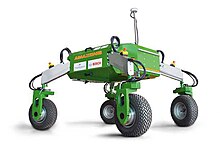Site-specific fertilization

Site-specific fertilization refers to the consideration of growth and soil differences within a field with the help of technology and is an important component in precision farming . Due to the structural change in agriculture, the fields are getting bigger and bigger. Differentiation within a field is therefore necessary. The basic goal is to apply the right product in the right amount at the right time and in the right place. This requires a basic nutrient inventory in order to be able to recognize the existing distribution of the nutrient contents.
Basics
Site-specific fertilization differs from previous practice in that specific information about stand and soil differences is generated and used for an application measure.
Problem
Through uniform fertilization and at the same time different withdrawals from the crops, there is a heterogeneous, unsuitable distribution of nutrients in a field.
Online and offline procedures
Depending on the area of application, a distinction can be made between online and offline processes. In some cases, minimum and maximum quantities are specified by offline methods, with the fine adjustment then being controlled by online sensors.
Offline procedure
For applications such as basic nutrient fertilization, sowing and soil cultivation, offline methods are used. Offline means here that location maps must first be generated before fertilization. The field is divided into small squares (e.g. 20 by 20 meters) on the home PC. A quantity of fertilizer is then assigned to each square. The job computer of the fertilizer spreader can then process such an application map while driving. The tractor receives its position from a GPS receiver .
In the offline process, the following parameters and data sources can be used to create an application map prior to the actual fertilization:
- Experiences of the farmer as well as through monitoring
- Yield maps from combine harvesters
- Soil maps of the Reich soil estimate
- Nutrient distribution maps generated by soil samples
- Aerial photos as well
- Terrain forms
Success control is carried out via the automatic yield mapping on combine harvesters. Research is carried out particularly in the field of automation of data acquisition and application.
Online procedure
Due to the great temporal and spatial heterogeneity, online plant sensors have become established for nitrogen fertilization. Various manufacturers have developed measuring devices to assess the number of plants while driving the fertilizer spreader.
Limitations of use of online systems
Online sensors can hardly be used in all processes in which fertilizer is applied once. For example, no control is possible with under- root fertilization in maize cultivation, since the fertilizer is applied with the seed and therefore there is no analyzable crop. The same applies to fertilization strategies with doses applied very early, e.g. B. with stabilized fertilizers or the cultan method . What all sensors have in common is that a minimum crop density / size is necessary in order to obtain a clean measured value. This essentially depends on the measuring surface, the measuring geometry and the measuring method. For example, you can only work with the Cropmeter from advanced shooting, otherwise the plant height is too low for the pendulum. All optical sensors also require a minimum floor cover, as otherwise the measured values will be falsified by reflections on the bare floor. This is usually achieved by the end of tillering .

